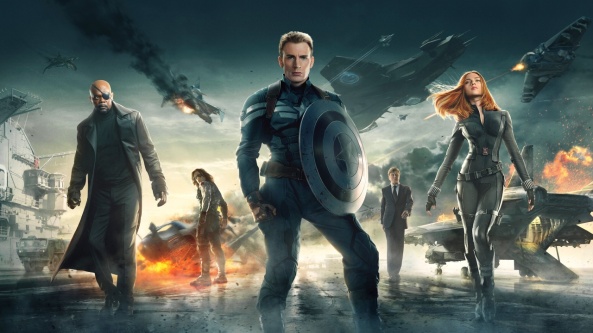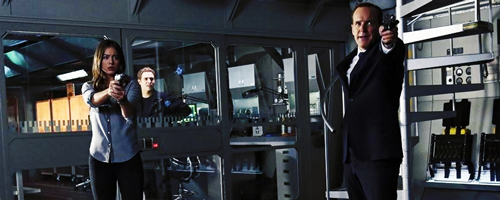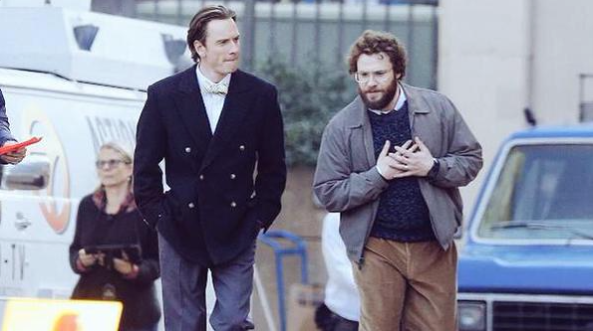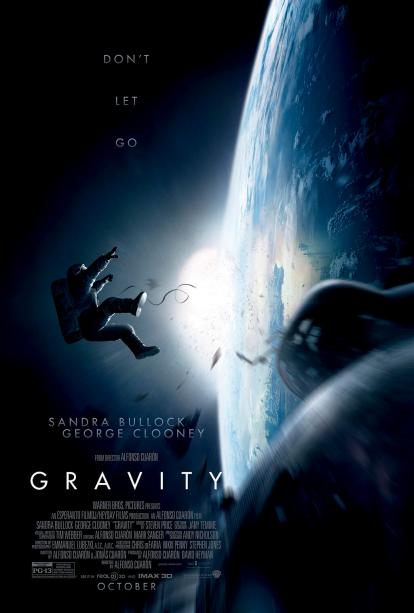It wasn’t until I saw Captain America: The Winter Soldier and the last six episodes of the first season of Marvel’s Agents of S.H.I.E.L.D. that I realized just how radical an experiment Marvel Studios is performing with their Marvel Cinematic Universe (MCU) movies and TV shows.

S.H.I.E.L.D. goes down in flames.
I’m a huge fan of serial TV shows. The broadcast networks have traditionally objected to them because they don’t rerun well and are hard for viewers to catch up with if they haven’t been watching from the beginning, but it’s gotten to the point where, if a show doesn’t have a serious serial continuity, I don’t have any interest in watching it. It turns out that the formula developed many decades ago on radio for soap operas is, in fact, ideal for showcasing what makes television in many ways superior to movies — i.e., the long-term ability to develop characters, relationships and situations such that the whole of a television series becomes greater than any of its individual episodes. But what Marvel Studios is doing with the MCU is even better than serial television. They’ve taken the concept of serial content in a series — of movies, of TV shows — and made it three or even four dimensional. They’re effectively doing something that I’ve only seen done before in one medium: comic books.
Let me back up for a moment. Marvel Studios is the Hollywood wing of Marvel Entertainment Group, which also publishes the Marvel line of comics. That’s the line where, back in the early 1960s, writer/editor Stan Lee and a few artists, primarily Jack Kirby and Steve Ditko, created what have become some of the most popular superheroes ever to don spandex unitards. The difference is that, in the 60s, their popularity was isolated to comic books and a few animated television shows. Today their popularity has expanded to movies and live-action television (though one character, the Incredible Hulk, achieved live-action TV success as far back as the late 1970s).
Marvel Studios was initially created in 1996 as a clearing house for licensing movie and TV rights to those heroes and, though it did a remarkably good job of attracting buyers, those buyers did an even better job of making money from Marvel-owned properties. Sony parlayed the Amazing Spider-Man into an ongoing series of summer blockbusters and Twentieth Century Fox has created what is, if anything, an even more popular series of movies out of the X-Men and their most popular solo member, Wolverine. (The Hulk, who was initially licensed by Universal, has had a somewhat more checkered cinematic history, and The Fantastic Four, while they turned a profit for Fox, generally proved to be a critical embarrassment in movie form. Fox is scheduled to reboot that series in summer 2015.)
In 2004, Marvel Studios realized that if other companies were making this much money off their characters, they could make even more money, or at least keep a larger percentage of the profits, if they made the movies themselves. They would also have more control over what was done with their characters and concepts. Over the next few years they quietly reacquired the rights to superheroes who either hadn’t done well for other studios (the Hulk) or had never even been given their own films (Iron Man). In 2008 Marvel Studios surprised everyone, or at least critics, by releasing a remarkably good film based on the latter character, who had mostly been a second-string superhero in the comic book world, starring Robert Downey, Jr., as alcoholic billionaire and arms merchant Tony Stark, who escapes from Afghan terrorists and a potentially heart-stopping load of shrapnel in his chest by building a supersuit that not only keeps his heart beating but lets him slug bad guys like the Hulk and fly through the air like Superman.
The real surprise, though, comes at the end of the film, mostly after the credits, when Stark is recruited by Clark Gregg’s Agent Phil Coulson and then Samuel L. Jackson’s Nick Fury to become part of the Avengers Initiative, a superhero collective being assembled (a pun that old Avengers fans will get) by Marvel’s superspy organization S.H.I.E.L.D. The same basic coda was appended, in one way or another, to the next three films in what Marvel Studios was now calling the MCU: The Incredible Hulk (2008), Thor (2011) and Captain America: The First Avenger (2011). (I’ve skipped Iron Man 2 (2010), a film for which this now predictable coda would have been redundant.) While each of these movies was basically standalone or the launching point for a series, it was becoming clear that they were also part of a larger whole. This whole, which eventually became known as Phase One, culminated in Marvel’s The Avengers, the highest-grossing movie of 2012 and the point at which it became clearest that all of these films were taking place in a shared universe, something that had only been hinted at up until then. This shared universe concept is common in superhero comics and has resulted in continuities so tangled that you pretty much need Wikipedia to sort them out, but it has only occasionally been used in films, so occasionally that I’m having trouble thinking of examples. (It’s more common in television, where character crossovers between shows and spinoffs from hit shows were almost a requirement in the 70s and 80s and still occasionally occur, with the interconnections between the Law and Order and CSI shows in the late 2000s probably being the most recent examples, unless the NCIS shows are doing something similar.)
Marvel’s The Avengers took elements and characters, some of them quite minor, from all of the previous films and threw them together into one big superhero soup. Marvel had been doing this in the Avengers comic books since 1963 and comic books in general had been doing this at least since DC Comics launched the Justice Society of America in All-Star Comics #3 back in 1940. Having such a series-jumping chronology in the movies was remarkable but it didn’t become extraordinary until it made the leap to television in the fall of 2013 with Marvel’s Agents of S.H.I.E.L.D., a direct spin-off from Marvel’s The Avengers.
I’ve talked before about how I had great hopes for Agents of S.H.I.E.L.D. and also about my frustration that it was taking its sweet time about realizing them. The reason why it was taking so long finally became apparent with the 17th episode, “Turn Turn Turn”: The show’s writers had been waiting for the second Captain America movie, Captain America: The Winter Soldier, to come out.
Just as Captain America: The First Avenger had been, quite unexpectedly, the best movie of Phase One, Winter Soldier was the best movie so far of Phase Two and possibly the best MCU movie yet, better even than Marvel’s The Avengers. (To be fair, Joss Whedon was handed a nearly impossible task in writing and directing The Avengers. He had to balance at least half a dozen major characters, four of whom had film series of their own — or maybe three, the underperforming Hulk having apparently been phased out after Phase One — and all of whom had to be given roughly equal screen time and importance to the plot. Not surprisingly, the standout was Tom Hiddleston’s Loki, borrowed from the Thor films, who chewed the scenery with charmingly vengeful gusto as the movie’s villain. More surprisingly, the other standout was Scarlett Johansson’s Black Widow, who I’m pretty sure first hit the screen in Iron Man 2, with her clever backhanded method of interrogating villains by making them think they’re interrogating her.)
Winter Soldier ends with — stop here if you’re one of the few MCU fans on earth who still don’t know what happens — the near total disintegration of S.H.I.E.L.D., which turns out to have been riddled since World War II with sleeper agents from their sworn enemies, the Nazi carryover organization Hydra. The movie ends with Captain America more or less triumphant but S.H.I.E.L.D. in shambles and Samuel L. Jackson’s Nick Fury erroneously believed to be dead. And that’s where it impacted the TV show. Agents of S.H.I.E.L.D. in the absence of S.H.I.E.L.D. had become a program without a premise and that suited it beautifully. After floundering all season in search of a theme, it had finally found one: a team of agents without an agency trying to defeat the enemy that had stolen it out from under them.

Things fall apart and S.H.I.E.L.D. becomes very centered.
For the final seven episodes of the season, S.H.I.E.L.D. was the best thing on television — yes, even better than Game of Thrones, which is straining admirably not to start plodding toward its climax the way George R.R. Martin’s books are doing. Agent Coulson’s team developed personality along with purpose. They fought against one another — Agent Ward turned out to be one of the sleeper agents — as well as against other agencies and ended up as a team of self-described vigilantes. The final episode resolves all this a bit too neatly, or at least too quickly, but it leaves some interesting plot threads dangling and the hint that at least one of those threads is going to generate the premise for the second Avengers film, which will terminate Phase Two in 2015.
It’s the way that the MCU continuity has not only jumped back and forth between movies but the way (and the speed) with which it has jumped between movies and TV (and apparently back again) that makes it revolutionary. (There was only a four-day lag between the opening of Winter Soldier and the introduction of its aftereffects into the show.) It would still be possible for a newcomer to jump into the multidimensional network of the MCU without being completely confused, but that window is rapidly closing and I would expect that, by some point in Phase Three, figuring out not only the plot but the interconnections between films, characters and TV shows (with yet another MCU television series, Agent Carter, debuting during S.H.I.E.L.D.‘s midseason hiatus in the 2014-2015 season) might become nearly impossible for a newbie.
This is clearly a studio executive’s nightmare and precisely the reason that broadcast television has fought — in vain, fortunately — against serial TV shows. If the audience doesn’t buy in early, it becomes extremely difficult to buy in late. But the way in which we watch television and movies is changing. We don’t necessarily catch TV shows while they’re on the air, the way we used to in the long-ago 20th century. We DVR them or buy the DVD sets or we get them On Demand or we binge watch them off Netflix or Amazon Prime Streaming. If we’re really desperate we resort to certain Internet back channels, which I’ll leave unnamed, to get our hands on content. The producers of Breaking Bad credited Netflix (and probably some of those back channels) with the show’s abrupt surge of viewership in its two-part final season, with viewers who had finally gotten word about how good the show was rapidly catching up through all-day streaming sessions.
My friend Sean Tucker thinks Marvel Studios is using the MCU to position themselves for a brand new media world and I think he’s right. Now that widescreen TVs with Internet connections have come to dominate the living room, the age of genuine on-demand viewing, which we’ve been promised since at least the 1980s, has arrived at last and I for one wouldn’t mind seeing the cable-TV companies die out altogether. (Unfortunately, they also own much of the Internet infrastructure and until that de facto monopoly is taken away, the true age of multidimensional media is going to be postponed — but I doubt for very long.)
Very soon now, we’ll be watching television and movies in the way people have long read comic books — picking up back issues and reading new ones in whatever order necessary to follow tangled continuities or just indulge sudden whims. To some extent, we’re already there — Amy is downstairs now binge-watching the entire seven years of West Wing on Netflix, something I did a few years ago myself — and I think we’ll need the original thinking of companies like Marvel Studios, which is taking continuity concepts from comic books and repurposing them for higher-budget visual media, to provide content that fits the new way we view what soap opera fans have long referred to as “our stories.” The multidimensional interconnections provided by the MCU may be the perfect model for a world in which TV and movies are only distinguishable by the size of the screens we watch them on — and much of the time not even by that.
I, for one, am thrilled to see the new era arrive. I just wish it hadn’t taken so long.




